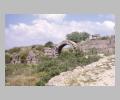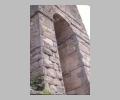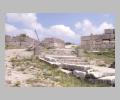| Summary: | Capital city of the hellenistic kingdom of Pergamon. |
| Type: | Fortified city |
| Region: | Mysia |
Periods:
Hellenistic
Roman
Physical:
The oldest section of Pergamon, the acropolis or upper city, sits on an impressive steep ridge between two tributaries of the Caicus river. The ridge is naturally fortified on all but the S side which slopes down to the Caicus valley floor. The Caicus valley provides access from Pergamon to the Aegean coast and the port town of Elaea in the W and the Persian Royal Road to the E.
The upper city, which was fortified in the 4th or 3rd century B.C. contains the 3rd century Sanctuary of Athena, the oldest cult center of the city as well as palace quarters, barracks, and arsenals. In the 2nd century B.C. the 10,000 seat theater, the library adjacent to the Sanctuary of Athena, and the Great Altar of Zeus and Athena were added. In the 2nd century A.D. the monumental Trajaneum was erected on what must have been an earlier unknown cult center. From the upper agora a paved main street leads S and downslope to the middle city.
The city of Pergamon began to extend down the S slope in the 3rd century B.C. and during the 2nd century a massive building program completely transformed the entire lower slope. The major construction in the area was the gigantic gymnasium complex which extended down three large terraces linked by vaulted stairways and passages. The complex encorporated three open training courts, a covered track or xystus, a small theater or odeum, several shrines, and two large baths. Other major sections of the middle city included the Sanctuary of Demeter and Kore and, below the gymnasium along the main street leading to the Eumenes' Gate, the lower agora. North and E of the gymnasium massive terraces support the streets and houses of the residential quarter. In the first half of the 2nd century B.C. Eumenes II strengthened the entire fortification system of Pergamon and enclosed all of the middle city, which extended almost to the base of the south slope, within the new walls.
During the Roman Imperial period the city continued to expand southward and spread over the plain and the area occuppied by modern Bergama. The large Sanctuary of the Egyptian Gods (the "Kizil Avlu"), numerous bridges, and remains of the Roman stadium, theater, and amphitheater remain visible today.
Description:
The earliest material from Pergamon indicates that the site was settled as early as the 8th century B.C. Because of its distance from the sea, however, Pergamon was probably not a Greek settlement and little is known about the earlier centuries. The city is first mentioned in history in 399 B.C. and at that time it was in the hands of a local Greek tyrant.
Pergamon emerged as a power during the struggle for territorial control following the death of Alexander the Great in 323 B.C. By the middle of the 3rd century Pergamon had been established as an independent state under the leadership of the Attalid dynasty. The power of the Attalids and the city grew as a result of successful battles against the Gauls of central Anatolia and careful political alliances with Rome.
The peak period of Pergamene power and achievement was reached during the reign of Eumenes II (197-159 B.C.). The kingdom had grown to include most of western Anatolia and was rich in agriculture and industry. Noted industrial exports included textiles, fine pottery, and "Pergamene paper" or parchment. The last industry developed when Ptolemy, reportedly jealous of the growing fame of the library in Pergamon, prohibited the export of papyrus from Egypt. Eumenes II enlarged the city of Pergamon to include all of the southern slope and enclosed the city with a new and stronger fortification wall. In addition to the major new constructions in the lower city Eumenes also commissioned the Great Altar of Zeus and Athena, the theater, and the new library in the upper city.
In the 2nd century B.C. Pergamon rivalled Athens and Alexandria as centers of Hellenic culture. The city possessed one of the greatest libraries of antiquity, monumental gymnasia, and numerous religious sanctuaries, including the Asklepion outside the city walls. Pergamon was a haven for noted philosophers and artists and was the center of a major movement in Hellenistic sculpture. The Attalids supported the arts and learning in Pergamon and elsewhere and made major donations, such as the Stoa of Attalos II in Athens.
The last Attalid ruler, Attalos III, bequeathed the kingdom of Pergamon to Rome in 133 B.C. During Roman rule the prosperity of Pergamon continued and the city had a period of commercial expansion. The city itself expanded to the plain S and W of the acropolis across the flat land now occuppied by modern Bergama.
After a slight decline in the 1st century A.D. Pergamon went through a second period of greatness in the 2nd century A.D. New monumental structures were completed, including the large (ca. 300 x 100 m) sanctuary to the Egyptian gods in the center of the Roman city. The Sanctuary of Asklepios grew in fame and was considered one of the most famous therapeutic and healing center of the Roman world. Galen, after Hippocrates the most famous physician of antiquity, was born at Pergamon and received his early training at the Asklepion.
By the end of the 2nd century A.D. Pergamon had become an important Christian center and the monumental Temple of Serapis in the sanctuary to the Egyptian gods was converted to a church. Economical decline, however, followed the weakening of the Pax Romana and Pergamon lost much of its importance. In A.D. 716 the city was sacked by the Arabs and as a minor provincial center changed hands several times in the Medieval period.
Exploration:
Excavations by the German Archaeological Institute have been conducted almost continuously since 1878. During the earliest work at the end of the last century major art works, including the entire Altar of Zeus and Athena, were brought to Berlin.
Sources Used:
Other Bibliography:





